For my homeschool year to be successful, I’ve got to have all of my ducks in a row. Getting started for a new year with Memoria Press actually starts a few months before classwork begins.
Setting up our school year is a LOT of work. For me, it’s best if I give myself plenty of time to tackle all the tasks slowly and methodically.
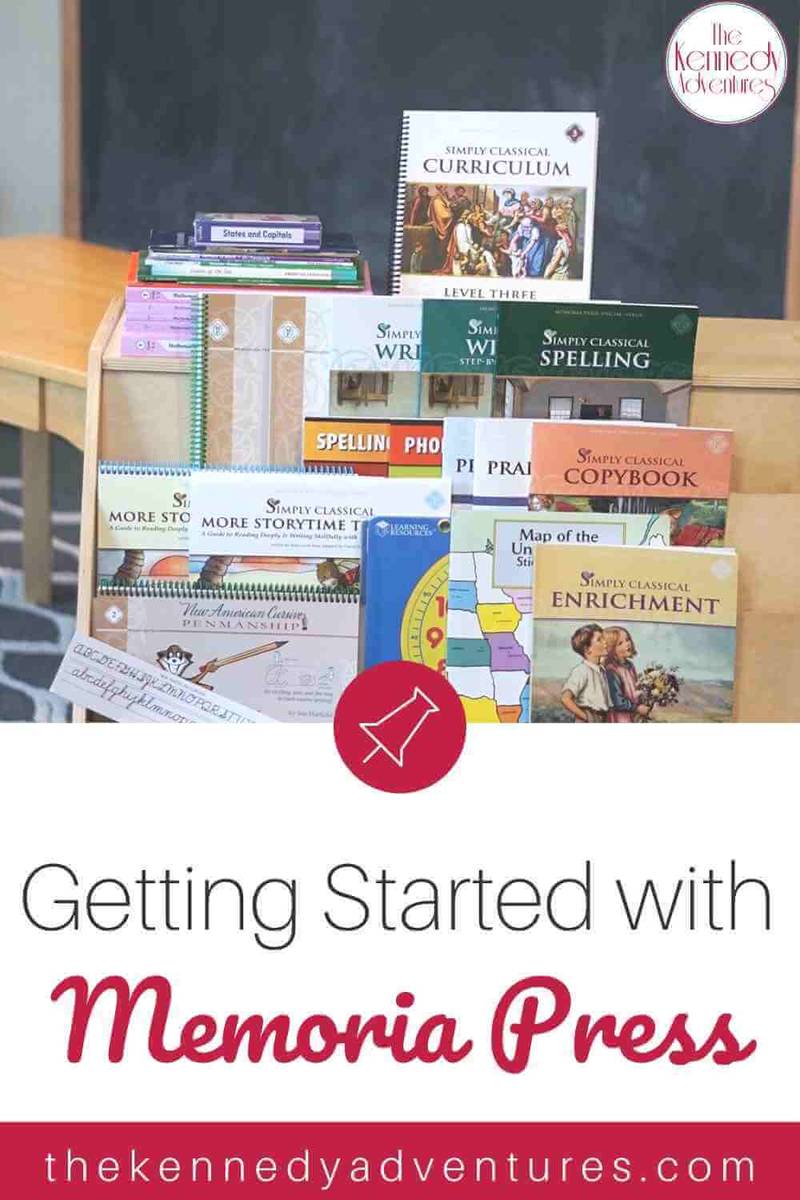
25 Tips for a New School Year with Memoria Press
1) Put Away the Materials You Don’t Need Right Now
Send your husband to the park or the pool with the kids, while you roll up your sleeves. You’ll need to clear out the old, to make room for the new.
This is also a great time to evaluate what worked well, and what was a flop.
I keep teacher manuals, novels and read-alouds, as well as student texts if they’re not too marked up. I don’t keep student guides, except for composition and copybooks.
If you have things to off-load, check your local homeschool groups or consignment shops. There’s also a Memoria Press Buy-Sell-Trade Facebook group.
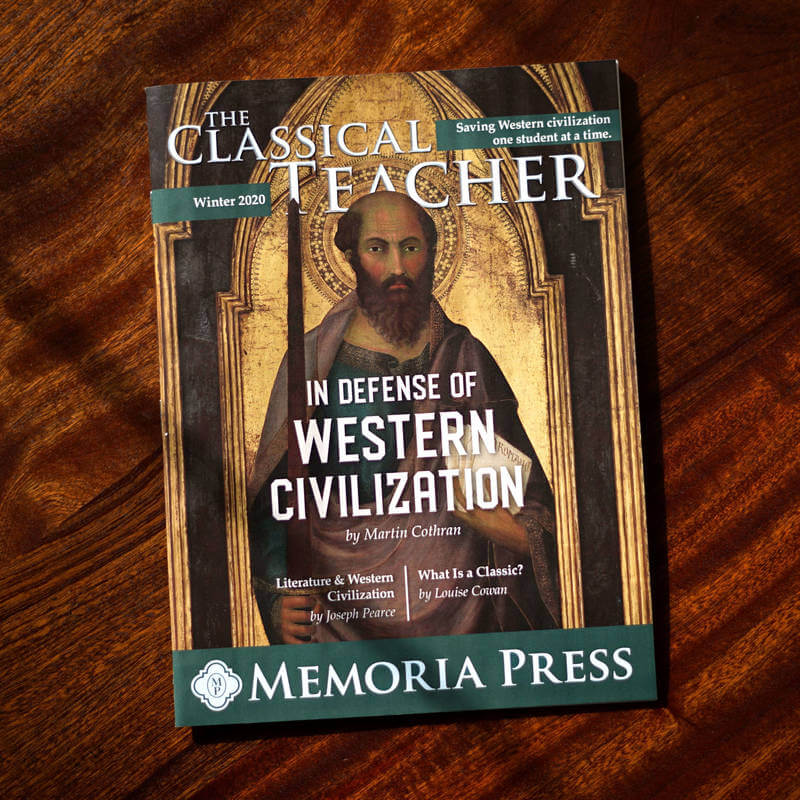
2) Get Ready to Order New Cores
Once I’ve gotten rid of my old stuff, put away teacher manuals and novels, then I’m ready to tackle ordering new cores.
Truthfully, I start working on this step shortly after Christmas. In January, when we’re all gung-ho about organizing, I start looking through my Memoria Press stuff.
I go through my old Memoria Press materials and start making notes. Questions I ask myself:
– What cores will we be doing in the fall?
– Is there a class we’ve postponed or shifted to another year?
– Any big events coming up in the next year? For example, Sacrament years are super busy for us (First Communion, Confirmation), so I need to make sure I leave plenty of breathing room. Other things to consider — homeschooling while pregnant, with a baby or toddler, or a move on the horizon.
I look at what Memoria Press suggests for each student, then I make it my own. I look at each and every subject and ask myself, “Do we need this? Can we handle the workload? Can we do it WELL?”
If I’m on the fence about any subject, I take a look at the scope and sequence, and discuss it with my husband, as well as my Memoria Press momma friends. I’ve also emailed and called the staff for advice.
Mom Tip: I order all materials straight from Memoria Press. This way, if a text is changed, I can have it updated easily. To save money, I usually order novels and read alouds from Thriftbooks.
3) Get Your Records in Order
Depending on where you live, you’ll have homeschooling legalities and paperwork to consider. Your best place for homeschool laws is HSLDA.
This is the time to get your ducks in a row. Refer to the rules in your state and make sure you’re all set. You may need a system for grades, attendance, portfolios and more.
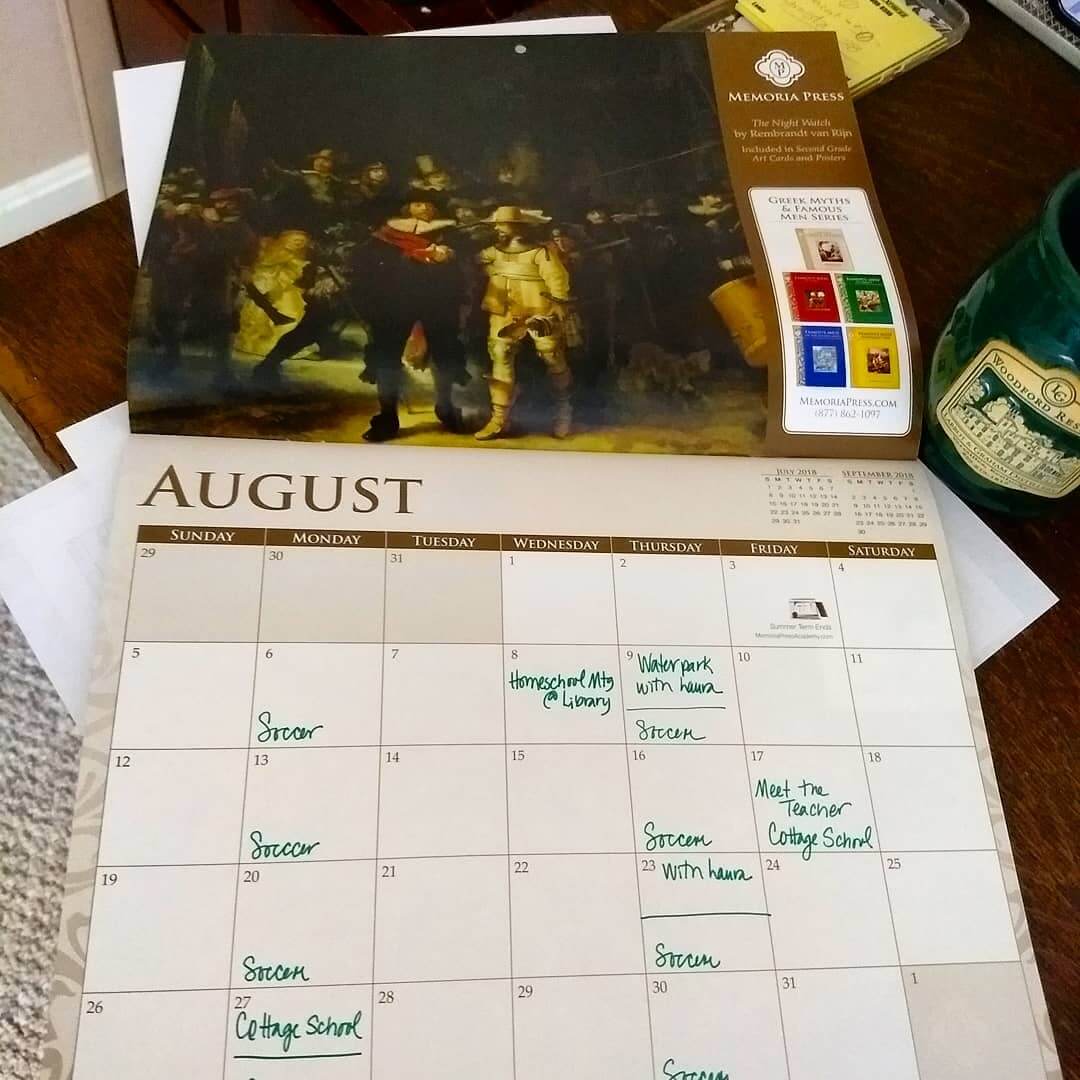
4) Decide on Your Schedule
Depending on your personal style, there are a few options to a homeschool yearly schedule:
- calendar year
- year-round
- traditional school calendar.
Because we take classes with the Memoria Press Online Academy, as well as in our local Cottage School, we use a combination of a traditional school calendar (August through May) plus year round classes.
During the school year, my children have the following classes:
Latin
Literature
Classical Studies
Composition
Math
Science (for 5th grade and up)
Over the summer, we follow a lighter schedule, working on geography and Christian Studies. (We also do math year round.)
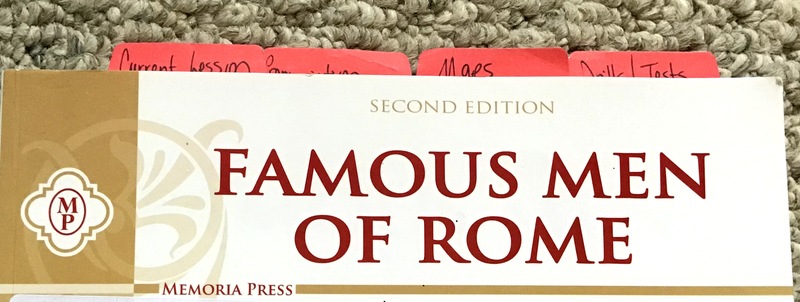 5) Tab the Teacher Manuals
5) Tab the Teacher Manuals
The teacher manuals and curriculum manuals (big book of lesson plans) are a wealth of information, but they can get overlooked in the shuffle.
I would encourage you to take the time to get to know these resources and what you’ll find inside.
As an example, I use the following tabs in my Classical Studies Teacher Manuals. (pictured is Famous Men of Rome)
– Current Lesson
– Drill Questions
– Quizzes and Tests
– Maps
This helps me to keep track of where we are, and I’m able to find things quickly, instead of fumbling.
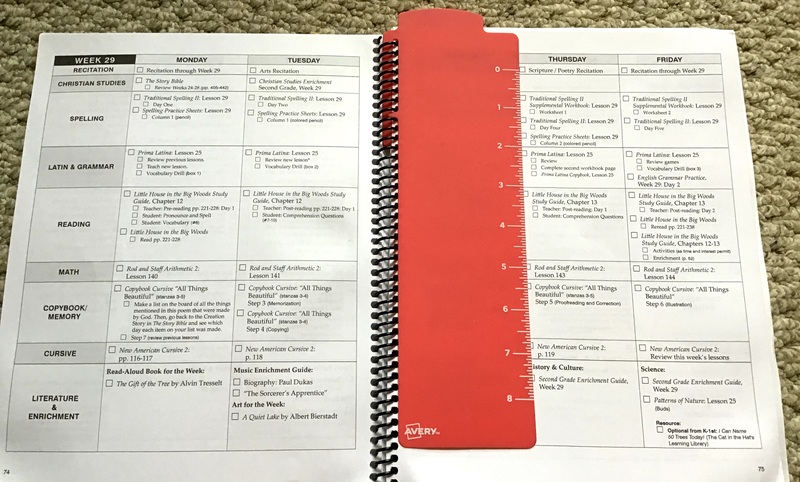
In the curriculum guide, I keep a big tab to mark our weekly place, as well as tabs for recitation and review.
6. Decide How to Store Your Memoria Press Homeschool Stuff
Much like my day to day homeschool, the way we organize all of our Memoria Press materials has changed over the years.
When we began with Rachel in kindergarten years ago, our setup was simple. We had a cart that contained all of her workbooks and my teacher manuals. Life was grand.

As we added more students, we moved to a workbox system. This worked fabulously until my Maeve became mobile. She dismantled my system in a hot minute, leaving papers, pencils and workbooks in her wake.
Later, we moved to storage bins for each child. As the number of subjects increased, this became unwieldy.
View this post on Instagram
Two years ago, I designated one bookshelf as my teacher spot. This works, as long as I’m diligent about putting my own things back where they belong.
Last year, my homeschool organization was a hot disaster. I was diagnosed with a automimmune disease, and I had to balance schoolwork with fatigue. Slowly, little by little, I finally tackled our giant assortment of Memoria Press materials and supplies, and figured out a system that works for us.
Check out the details of our current system HERE. (post coming soon)
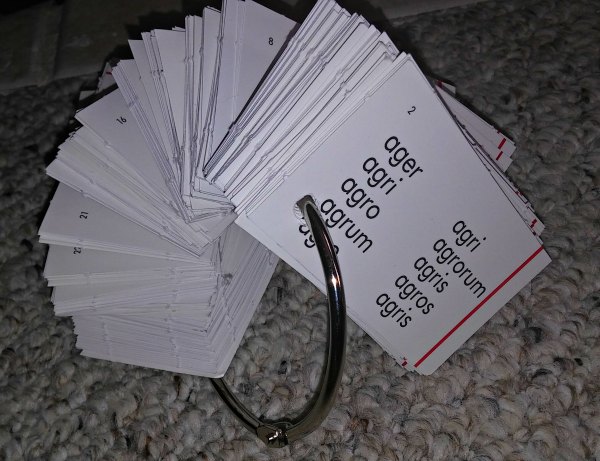
7) Organize Your Memoria Press Flashcards
Most Memoria Press subjects incorporate flashcard use. Pretty soon, all these flashcards can become overwhelming.
Before the school year begins, there’s a few tricks to keep those flashcards under control.
First, mark your flashcards. Some flashcards are obvious (Birds or Geography), but when you’re looking at a stack of Latin flashcards, you may not know which level they belong to.
You can add a small sticker, a small colored dot (Sharpies work best), or even writing SFL (Second Form Latin) or FMMA (Famous Men of the Middle Ages)on the cards.
Once you’ve identified the flashcards, then you’ll laminate them. I know that some people may think I’m over the top for doing this, but laminating has saved many of my cards from untimely spills. They’re also a lot more durable inside the lamination.
We use this laminator and these pouches. I laminate everything that I plan to use more than once — flashcards, art cards, posters and maps.
Once the cards are laminated, I hole punch the corner and contain them on a 3 inch binder ring.
Then, the cards in rotation for the year are placed on a hook on my teacher cart, ready to grab and review.
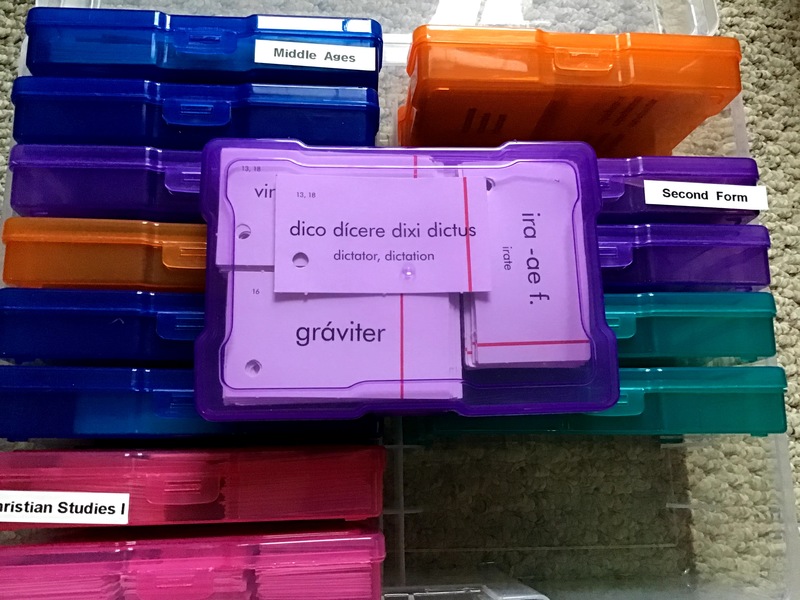 Cards we will need for upcoming years are labeled and organized into a photo keeper. This works for most cards, but there are a few that need something bigger.
Cards we will need for upcoming years are labeled and organized into a photo keeper. This works for most cards, but there are a few that need something bigger.
This is a good step to do at the end of the year — as you finish with your subject, label the flashcards and file them away.
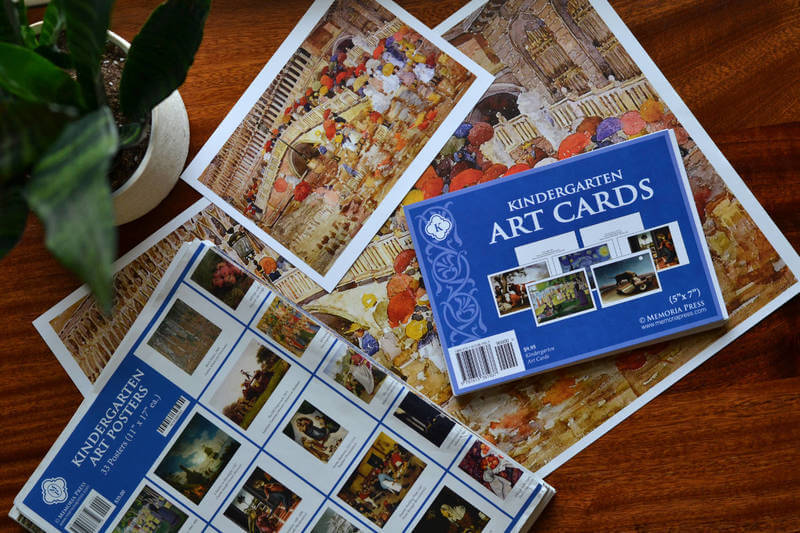
8) Think About the Awesome Art Cards
As part of the enrichment program for grades K-2, you’ll have a picture study each week. You’ll want to think about how you’ll want to organize these materials and how you’ll want to display them.
Ideas I’ve seen:
— Art cards on a bulletin board
— Art card in a frame
— Art card in a photo book
— Art card on a ring
— Art posters on the wall
In our home, we utilize the art posters AND the art cards. The poster gets laminated and goes on the wall, while the art cards are laminated and hung on a ring.
Mom Tip: If you laminate the posters, you’ll want to write the information on the back, similar to the art cards. I laminated all of mine before I realized that there wasn’t any artist information.
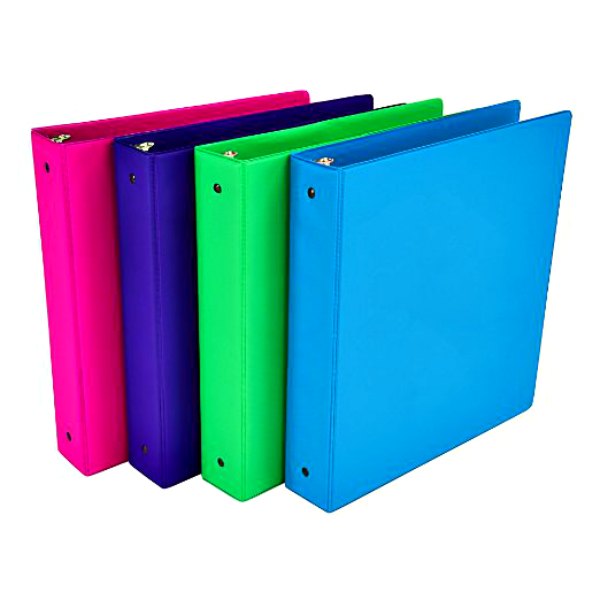
9) Prepare Your Memoria Press Quizzes and Tests
If you’re utilizing quizzes and tests in your homeschool, part of your prep is getting these together.
If you purchased your teacher manuals directly from Memoria Press, they will provide you with a PDF file of quizzes and tests in your account.
I take an afternoon to make sure I have plenty of paper, print out all tests and quizzes, then hole punch them and put them in a binder.
This saves me so much time in the long run. If I leave my children during the homeschool day to print a test, things have a way of falling apart.
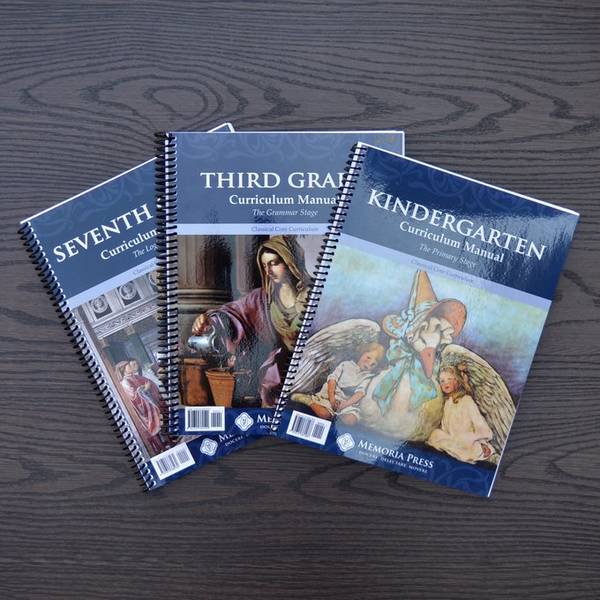
More Tips and Tricks for a New School Year with Memoria Press
10) Organize Your Memoria Press Lesson Plans
We use the Curriculum Guides for our lesson plans, but Memoria Press also offers individual lesson plans in a PDF format.
As part of your teacher prep, you’ll want to print these out and organize them in your binder.
If your students are old enough, you might want to print out an extra copy for them, so they can keep track.
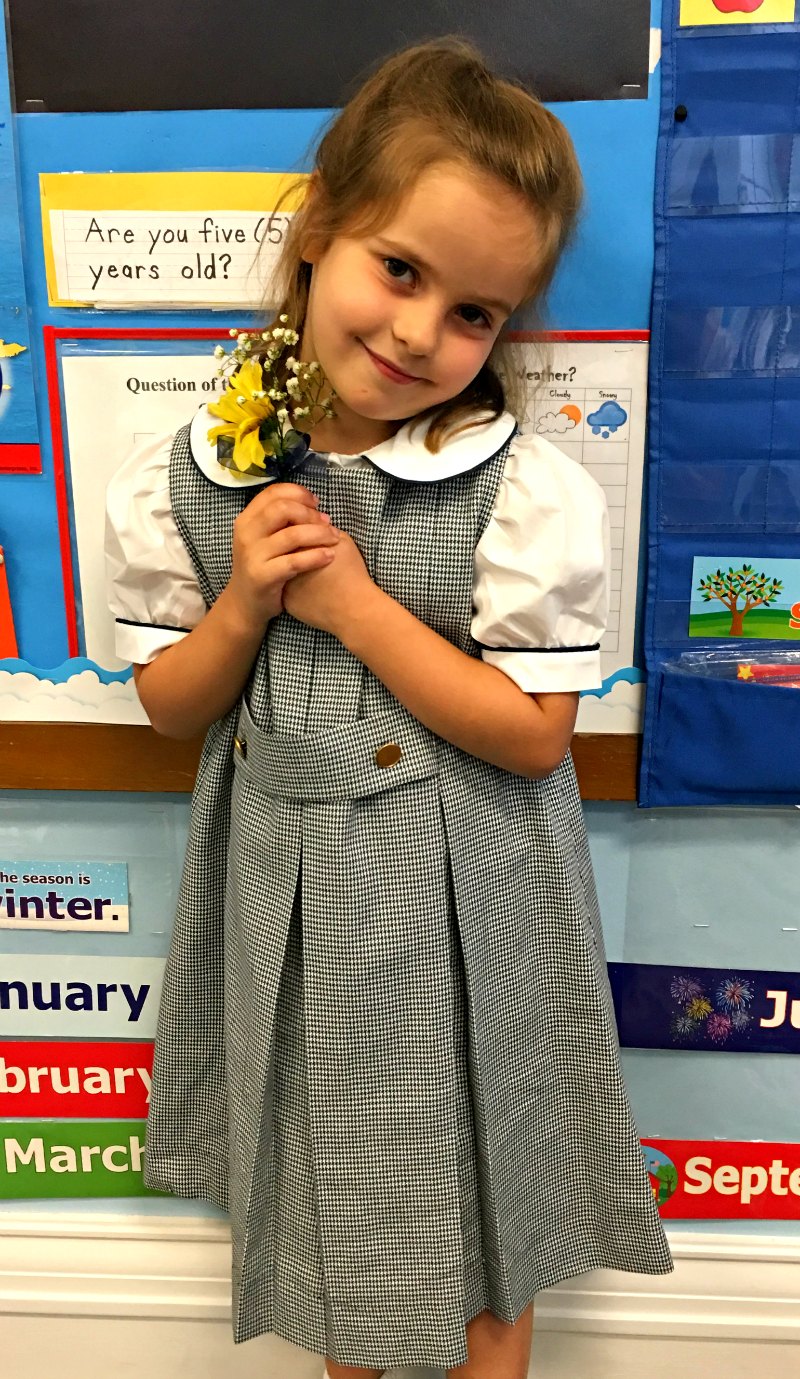
11) Will You Need Uniforms?
If you’re attending an Highlands Latin Cottage School or Memoria Press co-op that requires uniforms, you’ll need to allow yourself time to review the dress code and shop for uniforms and shoes.
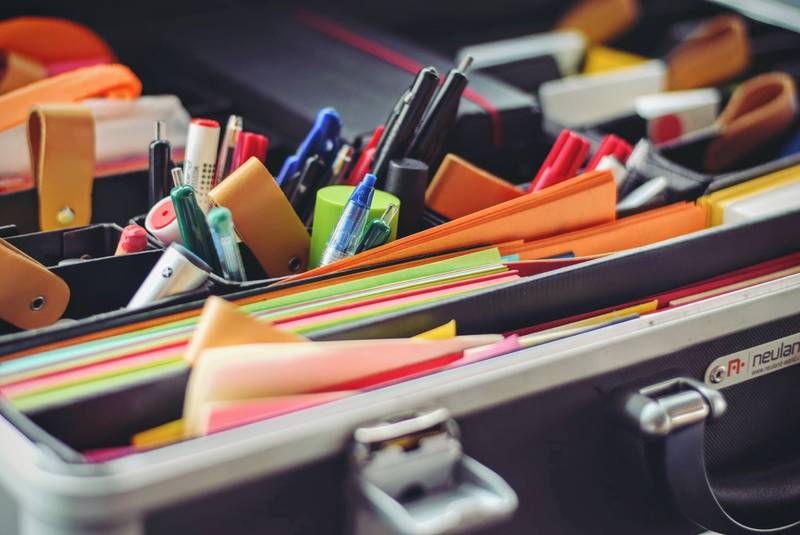
12) School Supplies
Here’s another area where it’s best to take inventory before you order. The siren song of school supply sales is strong, and you may end up with more than what you can reasonably use in a lifetime.
Take an honest look at what you need, what you have, and how the sales match up.
Our most important purchases:
Ticonderoga Pencils
Pink Pearl Erasers
Dry Erase Markers
Gel Highlighters
Flair Pens (for Mom)
Ultra Tabs
If you’re involved in a Cottage School or co-op, you may need special supplies for those classes.

13) Get Ready for Memoria Press Online Classes
If you’re in the Memoria Press Online Academy (MPOA) you’ll have some prep work there, too.
A few weeks before school begins, there will be some general MPOA orientation sessions, as well as individual class open houses. It’s a chance for parents and students to learn about the platform and work out any tech issues before classes begin. It’s also a way for teachers to introduce themselves and discuss the syllabus and how the class is arranged.
For my binder, I print out:
- The MPOA school year calendar
- Class syllabus
- First week’s assignment (when posted)
- Any sort of supply list

14) Cottage School and Memoria Press Co-op Prep
Most Cottage Schools and co-ops will have a meet the teacher night or Open House. You’ll be able to meet other families, check out the classrooms and meet the teachers.
You’ll usually get a packet of information as well. Things I file in my binder are:
- School calendar
- Class syllabus
- Teacher contact information

15) Get your Memoria Press Read Alouds Together
Looking at grades K-2, you’ll see that the enrichment program is based around weekly read-alouds.
You’ll need to consider how you’ll tackle this, depending on your time, budget, space, and resources.
You can purchase the read-alouds as a package, seek them out from used booksellers, or utilize your local library.
For our family, we’ve slowly purchased them through Thriftbooks.
If you’re using the local library, you’ll want to mark your calendar so that you’ll have plenty of time to request the book. (My library allows you to make a request for a future date.)
You’ll also want to think about how to organize these books, to keep them from disappearing. I add a circle sticker on the front cover with the grade level, and a piece of colored tape on the spine so I can quickly see at a glance that it’s a book for school.
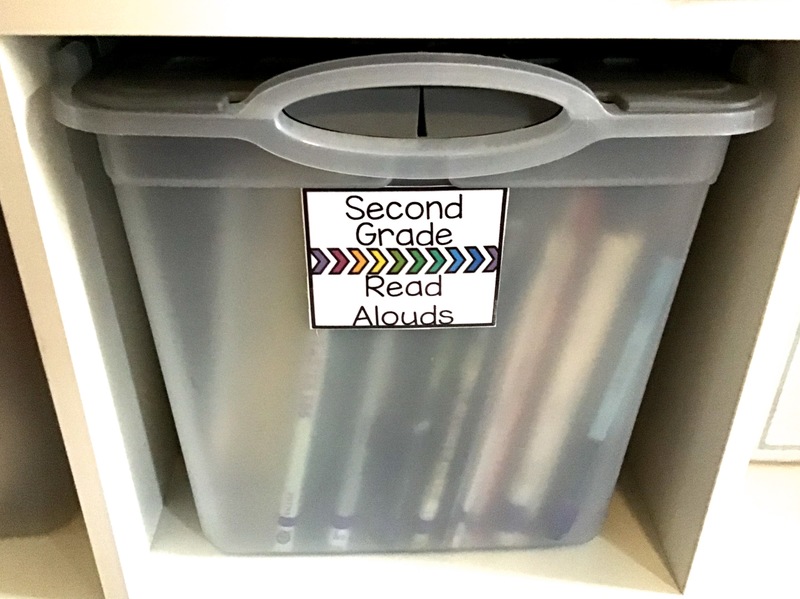 In our home, keeping these books on the shelves didn’t work that well, so enrichment books go in a separate bin.
In our home, keeping these books on the shelves didn’t work that well, so enrichment books go in a separate bin.
For your older students (grades 3-6), you’ll see read alouds listed for enrichment, as well as American History. These are optional, but you could use the same approach — plan to purchase them, or make arrangements to check them out from your library.
Another option for read alouds (as well as the literature selections) is Audible. It gives my voice a break and allows me to enjoy the story while I’m folding laundry.
16) Prep Work for Memoria Press Math
If you’re using Rod and Staff Math for your children who are K-3, this is the time to sit down with the Teacher’s Manual and start making math manipulatives and helpful visual aids for the year.
Trust me, it’s time well spent.
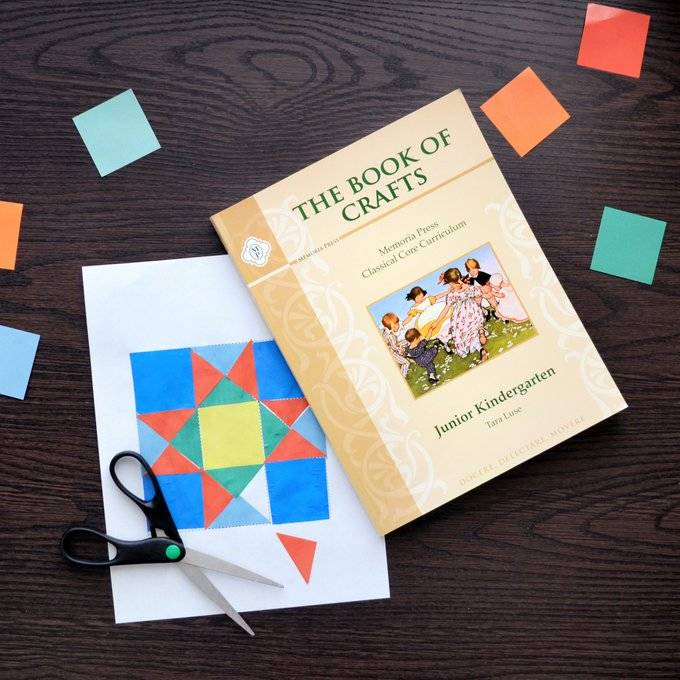
17) Organize the Memoria Press Arts and Crafts Materials
This tip is mostly for mommas with children in the preschool to second grade levels, but is also appropriate for families using Creating Art.
Check the supply lists in the front of each craft or enrichment guide. (There’s also a supply list in the front of the Creating Art book)
Look at your inventory first, then make a list and hit your favorite craft stores. Don’t forget to make a plan for storing your supplies.
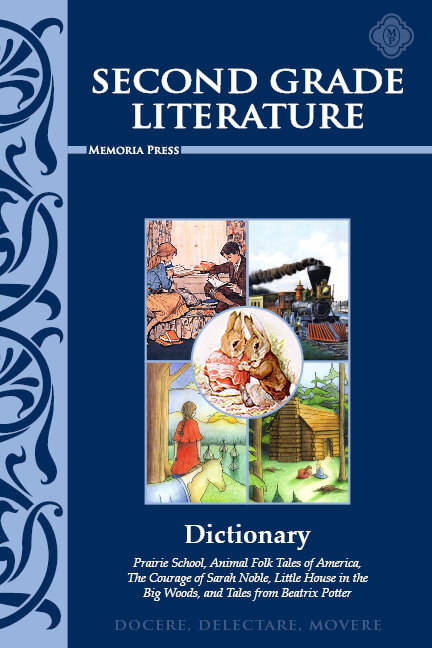
18) Memoria Press Literature and Classical Studies Dictionaries
In the literature and classical studies classes, students will have vocabulary words with each lesson. For second graders, there’s a printed literature dictionary to use. For 3rd grade and up, Memoria Press moms created their own dictionaries for classical studies and literature.
For a mom running multiple cores, this is a great way to encourage independence and dictionary use. These smaller, more specific dictionaries are less intimidating to younger students.
Find them here, then make a copy for your family.
Famous Men of Rome (post #42)
Famous Men of the Middle Ages (post #4)
3rd grade Literature (post #52)
4th grade Literature
5th grade Literature (post #42)
7th grade Literature dictionary (post #41)
US History Middle School (post #10)
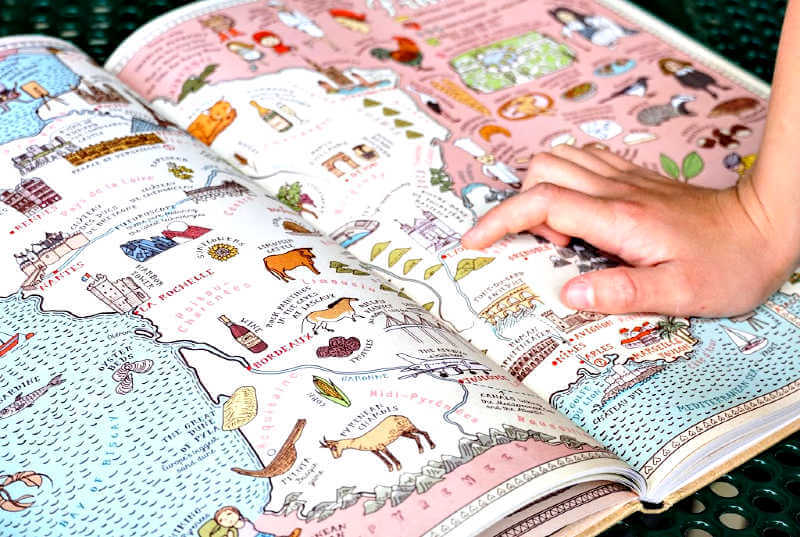
19) Memoria Press Geography Mapwork
If you have children in States and Capitals, or any of the Geography classes, mapwork is an important skill to learn.
For more practice, print extra maps for your students to fill in.
Mom tip: this also works for the maps in Classical Studies and Christian Studies.
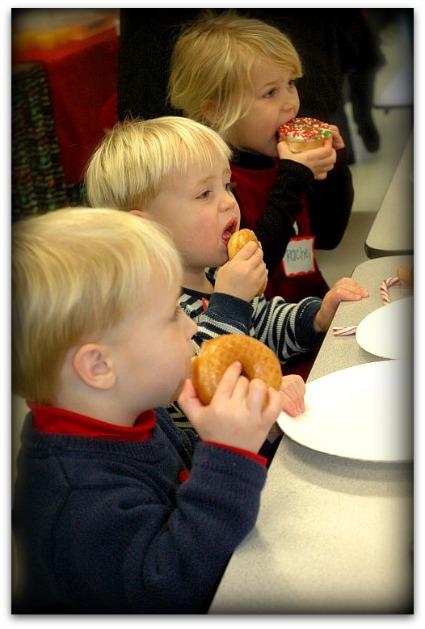
20) How to Feed your Homeschool Hobbits
It’s a running joke among my homeschool friends that our children eat 24 hours a day.
It’s also a proven fact, at least in my house, that I can’t do it all. If we’re having an amazing homeschool day, then we’re eating frozen pizza for dinner. If I have an incredible dinner on the table and the house is clean, then you can bet that ZERO schooling occurred. Keeping it real, folks.
Meal prep and planning saves me time, money and sanity, and it’s also better for my family’s health. I just have trouble making it happen.
While you’re in a summer lull, start planning meals for your family. I like ideas that are easy to prep ahead, and packed with protein.

21) Field Trip Fun
Part of the fun of homeschooling is the flexibility, right? We can hit the parks, the zoo and museums while everyone else is in school.
Take a look at your schedule and plan out some field trips. You can go solo, or head out with some friends.
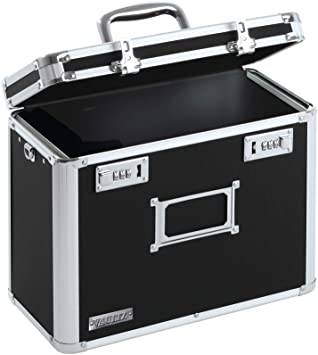
22) Secure Your Memoria Press Teacher Manuals
Once your kids hit second grade, it’s time to think about where you’ll keep your teachers’ manuals, which contain the keys to quizzes, tests, and workbook assignments.
I know you think that your sweet angel children would NEVER cheat. You may be right, and my kids are just bad eggs. (kidding!)
Basic facts — kids are human, and the temptation to take the easy road is there. It’s best to have the discussion and find your solution before cheating happens.
I use this locking box, which is just big enough for the teacher manuals I’m currently using. (I also hide candy or gluten free treats inside. Just saying.)
23) Memoria Press Music Appreciation
Memoria Press has made it so easy to incorporate music appreciation into your homeschool. The goal is to introduce your children to pieces of classical, timeless music so that they recognize and appreciate it. They don’t have to be able to pick out a cello, but they’ll recognize these pieces day to day life, once they’ve been exposed.
We use the weekly music selections in the K – 2 Enrichment program, and play them at breakfast, or while we’re working a puzzle. As part of my prep work, I make sure I have a playlist ready to go. Memoria Press has collected the playlists in one handy spot — stream them on iTunes, YouTube, or Spotify.
You’ll have to periodically check to make sure that the links aren’t broken, but a half hour of prep time saves my bacon when we’re busy.
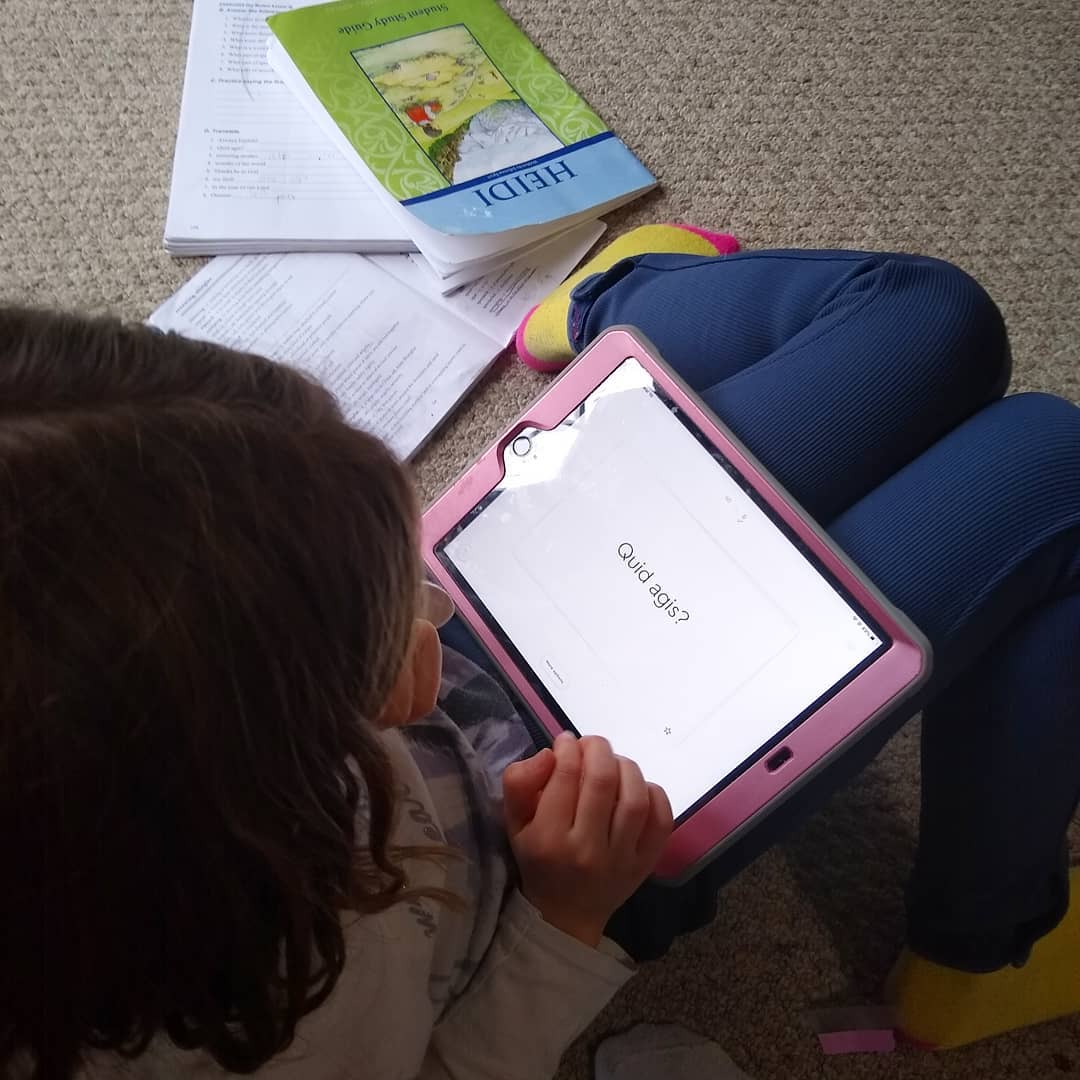
24) Memoria Press Review
If you’ve got multiple children at home, time for review can be dicey. There’s lots of flash cards to review, and only so many minutes in the day.
Enter Quizlet.
Within Quizlet, you can create flash card sets, search for sets already created, make folders, and assign these to your students. Creating or searching for sets isn’t difficult, but it can be time intensive, especially for Latin.
My preference is to take a couple of hours over the summer and create sets and folders for my children’s Latin, classical studies and science classes.
If you’re using sets pre-created by another user, double check to make sure they’re correct. There’s a thread over on the Memoria Press forum that lists some helpful tips for getting started.
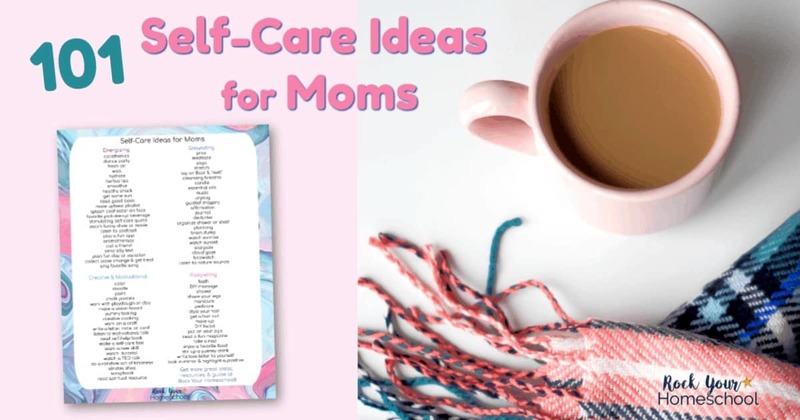
25) Do Something for Yourself
You’ve worked HARD to get your school year off to an incredible start. Now, it’s time for some self care.
An afternoon by yourself at the pool, your favorite tea on Subscribe and Save, new pens, a cute notebook, a new teacher outfit, or anything to give yourself an added boost of confidence and joy.
You’ve earned it! Now go tackle this year.
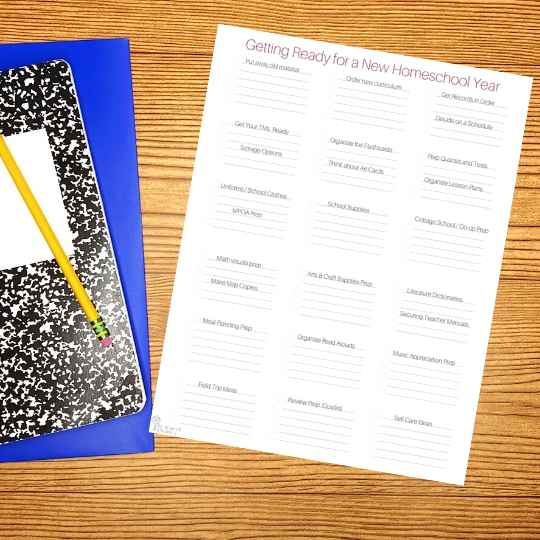
Checklist for getting your homeschool year off to a great start
To help me keep track of all the things I need to get done, I created a checklist. It’s easy to overlook something, so I print this out in the spring, stick it on my clip board, and tackle tasks as I have time.
I’ve got two versions — one contains all the tasks contained in this article, along with a blank list, so you can make up your own.
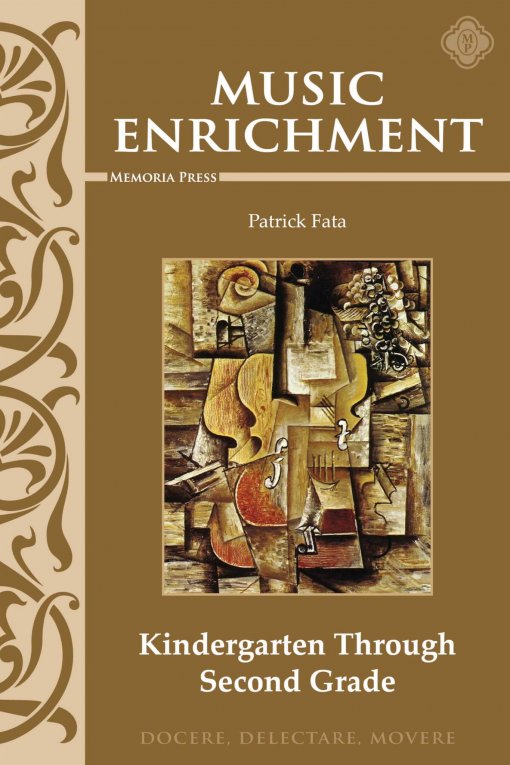
Dianna, this is perhaps the best curriculum post I’ve ever read in my 10+ years of homeschooling. What a blessing you are to me and all of the other MP mamas!
xo, Lauren
Was there a literature Grade 6 packet? I saw a 5th and 7th?
Maybe I will get lucky and look around!!
Sheri,
Thanks for reaching out! Honestly, I don’t know. I would click over and look at some of the posts in that forum thread.
Oh I love the bookmark idea! My husband made a rack of ‘hooks’ for us to hang our flash cards on which has been great. I love all your ideas!